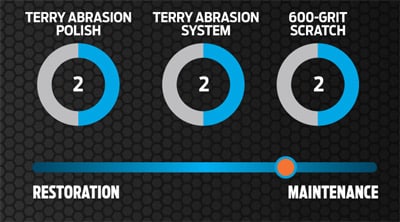Polymethyl methacrylate is generic for Plexiglas and other brands. This acrylic is tough, flexible and transparent. It makes an ideal material for boat windshields but scratches easily. With proper maintenance, and with these products, you can remove lighter scratches. Here’s how we tested them to see how they compare.
How We Tested
Testing Two Levels of Abrasion
To simulate everyday wear we rubbed a dry terry towel over an acrylic panel until fine marks appeared and then used the polish portion first.
To test our products on light scratching, we abraded our test panels with 600-grit paper and completed the entire directions process of each kit or product.
For test purposes, we keyed on only acrylic panels. Polycarbonate is sometimes used for boat windshields, but it comes with a warning that coatings on it can be damaged or destroyed by some restoration products.
Scorecard
1 = Abrasion not resolved
2 = Abrasion partially resolved
3 = Abrasion mostly resolved
4 = Abrasion perfectly resolved
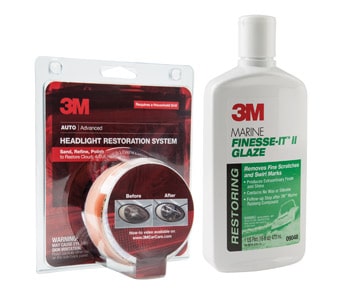
3M Headlight Restoration System and Finesse-It II
Kit: $17.97, Finesse-It II: $24.99; jamestowndistributors.com
Main Customer: Automotive
Description: The included drill-mounting buffer pad has a Velcro surface that accepts progressively finer grit sanding pads. Afterward, use the foam polish pad and the packet of polishing compound to finish the job.
Test Notes: Finesse-It II did the best job of removing terry scratches in one pass. For the 600-grit scratch test, the kit was the most aggressive and effective system tested. But it’s the last resort before windshield replacement. Everything you need but a power drill is in the kit. The mohair foam pad was gentle and thorough in the final polish.
Final Note: You may need two kits for larger windshields, but we used only a minute fraction of the supplies on our test patch.
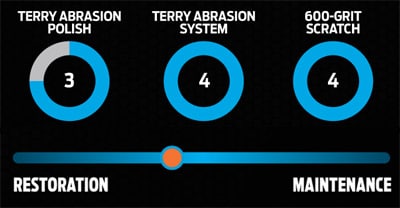
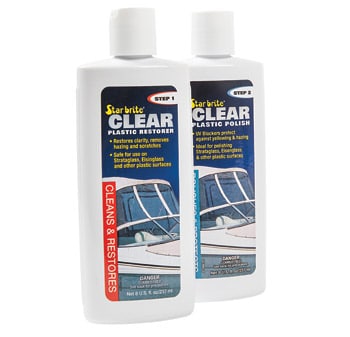
Star brite Clear Plastic Restorer and Clear Plastic Polish
Restorer: $12.34, Polish: $11.34; amazon.com
Main Customer: Marine
Description: Star brite markets these products separately but recommends using the restorer on damaged acrylic and other plastics to remove hazing, yellowing and fine scratches. Once the product has done its job, Star brite recommends Clear Plastic Polish be applied to finish the clarifying. According to the label, the polish adds UV blockers to protect against future yellowing and hazing.
Test Notes: Clear Polish was a “wetter” application than most but did fair work on the terry abrasions. So, we used the Clear Restorer, a thicker compound, and it raised the polish score from 2 to 3. Neither product was equal to the 600-grit scratch test, but we weren’t disappointed since they weren’t presented as being heavy-scratch removers.
Final Note: With great value, it’s ideal for keeping newer acrylics looking new.
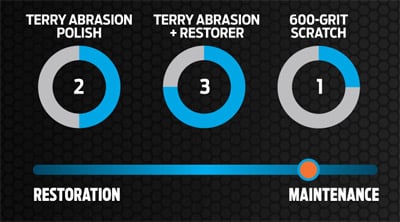
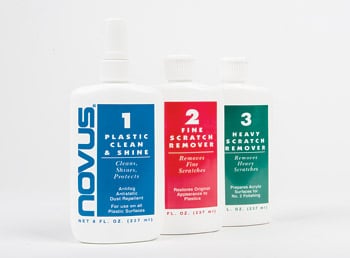
Novus 1, 2, 3 Plastic Clean & Shine and Fine and Heavy Scratch Removers
$7.55, $7.99, 5.99; amazon.com
Main Customer: Aviation
Description: Novus’ three-part system uses a higher grit in No. 3 for removing heavy scratches and preparing the panel for No. 2 (the fine scratch remover). The final treatment, No. 1, cleans, shines and protects, leaving a dust-repellent, anti-static and anti-fog surface behind.
Test Notes: This was the most effective full liquid system we tested in the scratch test but not as good as 3M. While the No. 1 polish scored only a 2 in the terry test, the No. 3 compound tied with 3M Finesse-It II in the terry abrasion category. Novus 2 and Novus 1 are comparable to Star brite Clear Plastic Restorer and Clear Plastic Polish in this test.
Final Note: Novus No. 3 fully repaired the terry scratches. This 3-2-1-punch system makes a great choice for all minor restorations and maintenance.
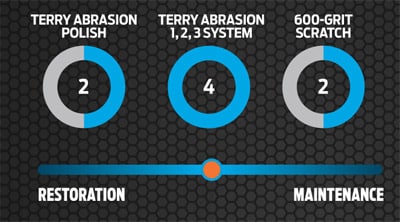
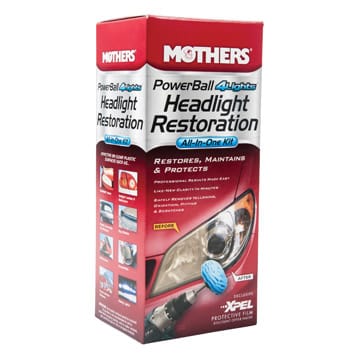
Mothers PowerBall 4Lights Headlight Restoration
$21.97; amazon.com
Main Customer: Automotive
Description: Connect the buffer ball to a power drill to ease labor. The kit contains number-keyed, foam-backed sanding pads. Begin with “one” to take off the most damage. Grit decreases with each pad. Finally, the Plastic Polish is added to clarify and protect the acrylic surface and to maintain its usefulness. A microfiber towel is included for the final polishing step.
Test Notes: Ideal for headlights, but the hand-sanding pads are too skimpy for a windshield. We sanded much longer with the hand pads than we did with the 3M power pads and found the hand work too onerous for a full windshield. The Plastic Polish had thicker consistency and makes an ideal product for acrylic maintenance.
Final Note: The power ball, however, is about the handiest polishing tool we’ve seen.
